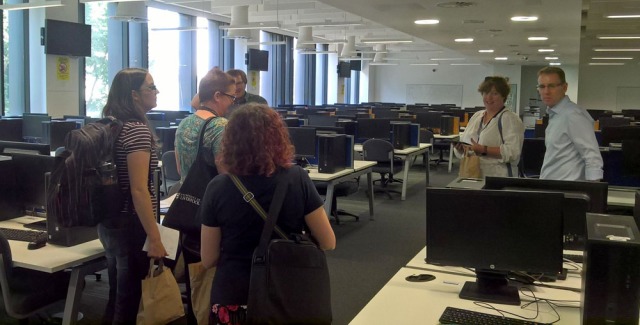The #connectedlearning space, in its many and various meanings, is central to my thinking about the future classroom. This is obviously epitomised in the concept of the #twalk. It was lovely to hear that Alex Spiers was leading a Twalk at the Liverpool University today – again looking at learning spaces (#livunitwalk). And it was lovely to ‘connect in’.

photo of #livunitwalk by Ben McGae @bmegae
In my work on digital and social media for learning, I often refer to examples of the connected classroom as being something we need to exploit more. The webinar is the classic form for such connectivity and the opportunities for enriching the classroom by bringing in connected voices and expertise. The idea of ‘connecting in’ relates to that notion of ‘expert performances’ in authentic learning theory and it is prominent in George Siemen’s principles of connectivism.
In my own current thinking about the meaning of ‘applied university’, the idea of connecting is really important. It describes how we must develop capabilities to “look and reach outwards to our world” as a dimension of epistemic fluency (Markauskaite & Goodyear, 2016) [more on that in a future post].
‘Bringing in’ and ‘expertise’ suggest a mono-directional relationship. At #MELSIG_SHU the other week I introduced the day with reference to ‘together we are expert’ being only full of curiosity and potential without connectivity. So, it was a joy to drop in as an outsider on the Liverpool walk and recognise the value of taking out, not only bringing in, knowledge. I know I brought something to the #twalk – the focus of the activity there mapped directly to my own scholarship, but what I gained and what was valuable for me, beyond that sense of networked warmth, was being involved in a review of the essential questions as discussed by a group of academics committed to excellent teaching (self-defined through the act of undertaking CPD on academic innovation).
As soon as I connected to the hashtag #livunitwalk I realised I may be intruding – crashing in on conversations that need to be owned by the Liverpool group alone. I was aware my externality may deter productive, challenging conversations even though my intention was to contribute. So I asked, “Am I crashing or connecting?” You might assume that if it is happening in social media you have a right to be there – it is an implicit invitation. Nevertheless, I think this assumption needs to be checked. I was welcomed.
As someone who has thought through the questions being discussed many times, I ensured my tone of voice was facilitative rather than didactic. I hopefully posed a few useful supplementary questions and the group in Liverpool were free to ignore them! And they were hopefully busy enough with their own thoughts!
Anyway, for me, #livunitwalk was an interesting opportunity to think about #twalks, social media for learning, and boundary crossing. Thank you!

Pingback: Productive failure, drawing and erasing – exploring visual literacies #twalk #possibilities | Tactile